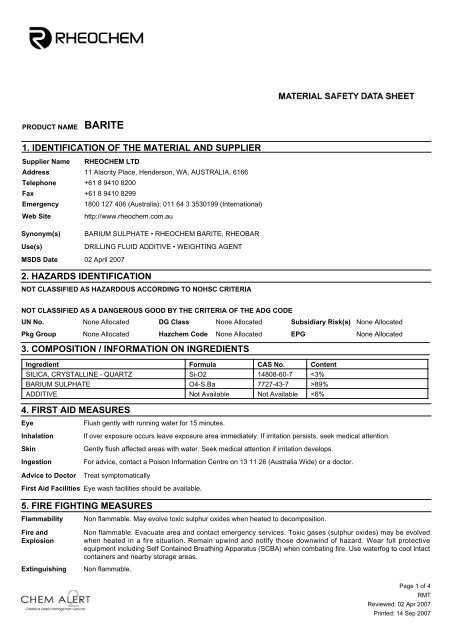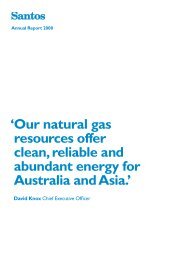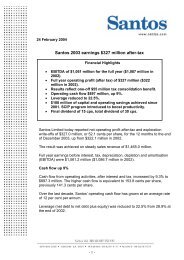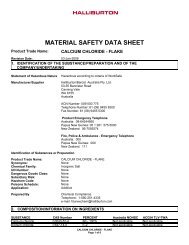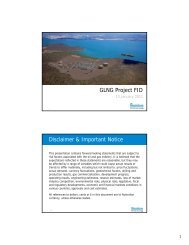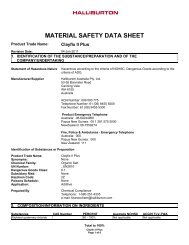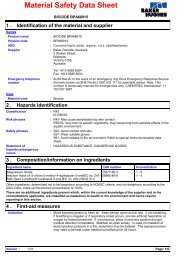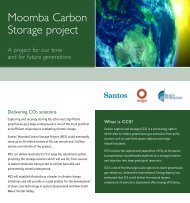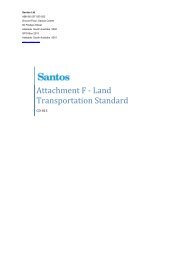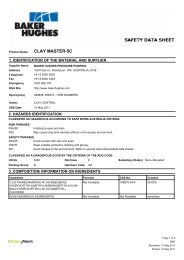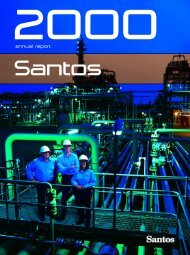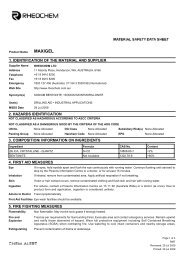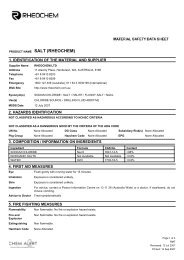MSDS - Barite (Rheochem) - Santos
MSDS - Barite (Rheochem) - Santos
MSDS - Barite (Rheochem) - Santos
You also want an ePaper? Increase the reach of your titles
YUMPU automatically turns print PDFs into web optimized ePapers that Google loves.
PRODUCT NAMEBARITE1. IDENTIFICATION OF THE MATERIAL AND SUPPLIERSupplier Name RHEOCHEM LTDAddressTelephoneFax11 Alacrity Place, Henderson, WA, AUSTRALIA, 6166+61 8 9410 8200+61 8 9410 8299Emergency 1800 127 406 (Australia); 011 64 3 3530199 (International)Web Site http://www.rheochem.com.auSynonym(s)Use(s)BARIUM SULPHATE • RHEOCHEM BARITE, RHEOBARDRILLING FLUID ADDITIVE • WEIGHTING AGENT<strong>MSDS</strong> Date 02 April 20072. HAZARDS IDENTIFICATIONNOT CLASSIFIED AS HAZARDOUS ACCORDING TO NOHSC CRITERIANOT CLASSIFIED AS A DANGEROUS GOOD BY THE CRITERIA OF THE ADG CODEUN No.Pkg GroupNone Allocated DG Class None Allocated Subsidiary Risk(s) None AllocatedNone Allocated Hazchem Code None Allocated EPGNone Allocated3. COMPOSITION / INFORMATION ON INGREDIENTSIngredient Formula CAS No. ContentSILICA, CRYSTALLINE - QUARTZ Si-O2 14808-60-7 89%ADDITIVE Not Available Not Available
PRODUCT NAME BARITEHazchem CodeNone Allocated6. ACCIDENTAL RELEASE MEASURESSpillageIf spilt (bulk), wear dust-proof goggles, PVC/rubber gloves, coveralls and a Class P1 (Particulate) respirator (if aninhalation risk exists). Absorb with moist sand or similar and place in sealable containers for disposal.7. STORAGE AND HANDLINGStorageHandlingStore in cool, dry area, removed from foodstuffs. Ensure containers are labelled, protected from physical damageand sealed when not in use.Before use carefully read the product label. Use of safe work practices are recommended to avoid eye or skincontact and inhalation. Observe good personal hygiene, including washing hands before eating. Prohibit eating,drinking and smoking in contaminated areas.8. EXPOSURE CONTROLS / PERSONAL PROTECTIONExposureStandardsBiological LimitValuesEngineeringControlsPPEIngredientReferenceTWASTELppm mg/m3 ppm mg/m3Barium sulphate NOHSC (AUS) -- 10 -- --Silica, Crystalline Quartz NOHSC (AUS) -- 0.1 -- --No Biological Limit Value allocated.Do not inhale dust/ powder. Use with adequate natural ventilation. Where a dust inhalation hazard exists,mechanical extraction ventilation is recommended.Wear dust-proof goggles and rubber or PVC gloves. When using large quantities or where heavy contamination islikely, wear coveralls. Where an inhalation risk exists, wear a Class P1 (Particulate) Respirator.9. PHYSICAL AND CHEMICAL PROPERTIESAppearance OFF-WHITE POWDER Solubility (water) INSOLUBLEOdour ODOURLESS Specific Gravity 4.20pH 8.2 (20% Slurry) % Volatiles NOT AVAILABLEVapour Pressure NOT RELEVANT Flammability NON FLAMMABLEVapour Density NOT AVAILABLE Flash Point NOT RELEVANTBoiling Point NOT RELEVANT Upper Explosion Limit NOT RELEVANTMelting Point > 1300°C Lower Explosion Limit NOT RELEVANTEvaporation Rate NOT AVAILABLE Autoignition Temperature NOT AVAILABLE10. STABILITY AND REACTIVITYChemical Stability Stable under recommended conditions of storage. Stable under recommended conditions of storage.Conditions toAvoidMaterial to AvoidDecompositionHazardousReactionsAvoid heat, sparks, open flames and other ignition sources. Avoid heat, sparks, open flames and other ignitionsources.Compatible with most commonly used materials.May evolve toxic sulphur oxides when heated to decomposition.Polymerization is not expected to occur. Polymerization is not expected to occur.Page 2 of 4RMTReviewed: 02 Apr 2007Printed: 14 Sep 2007
PRODUCT NAME BARITE11. TOXICOLOGICAL INFORMATIONHealth HazardSummaryEyeInhalationSkinIngestionToxicity DataEnvironmentLow Toxicity. Under normal conditions of use adverse health effects are not anticipated. Chronic exposure tocrystalline silica may cause lung fibrosis (silicosis), however due to the low levels of crystalline silica in thisproduct, chronic health effects are not anticipated with normal use. Crystalline silica is classified as carcinogenicto humans (IARC Group 1).Low to moderate irritant. Exposure may result in irritation, pain and redness.Irritant. Dust generation may result in mucous membrane irritation of the upper respiratory tract with overexposure. Chronic exposure to crystalline silica may result in lung disease (silicosis). Crystalline silica is classifiedas carcinogenic to humans (IARC Group 1).Low irritant. Prolonged and repeated exposure to dust may result in irritation and dermatitis.Low toxicity. With large doses ingestion may result in nausea, vomiting and gastrointestinal irritation.No LD50 data available for this product.12. ECOLOGICAL INFORMATIONThis product is not anticipated to cause adverse effects to animal or plant life if released to the environment insmall quantities. Fish toxicity: LC50 (Rainbow trout) = 7500 ppm/96 hour.13. DISPOSAL CONSIDERATIONSWaste Disposal Dispose of to an approved landfill site. Contact the manufacturer for additional information.Legislation Dispose of in accordance with relevant local legislation.14. TRANSPORT INFORMATIONNOT CLASSIFIED AS A DANGEROUS GOOD BY THE CRITERIA OF THE ADG CODEShipping NameUN No.Pkg GroupNone AllocatedNone Allocated DG Class None Allocated Subsidiary Risk(s) None AllocatedNone Allocated Hazchem Code None Allocated EPGNone Allocated15. REGULATORY INFORMATIONPoison ScheduleAICSA poison schedule number has not been allocated to this product using the criteria in the Standard for the UniformScheduling of Drugs and Poisons (SUSDP).All chemicals listed on the Australian Inventory of Chemical Substances (AICS).16. OTHER INFORMATIONAdditionalInformationRESPIRATORS: In general the use of respirators should be limited and engineering controls employed to avoidexposure. If respiratory equipment must be worn ensure correct respirator selection and training is undertaken.Remember that some respirators may be extremely uncomfortable when used for long periods. The use of airpowered or air supplied respirators should be considered where prolonged or repeated use is necessary.ABBREVIATIONS:ADB - Air-Dry Basis.CAS# - Chemical Abstract Service number - used to uniquely identify chemical compounds.CNS - Central Nervous System.IARC - International Agency for Research on Cancer.M - moles per litre, a unit of concentration.mg/m3 - Milligrams per cubic metre.NOS - Not Otherwise Specified.pH - relates to hydrogen ion concentration using a scale of 0 (high acidic) to 14 (highly alkaline).ppm - Parts Per Million.TWA/ES - Time Weighted Average or Exposure Standard.PERSONAL PROTECTIVE EQUIPMENT GUIDELINES:The recommendation for protective equipment contained within this Chem Alert report is provided as a guide only.Factors such as method of application, working environment, quantity used, product concentration and theavailability of engineering controls should be considered before final selection of personal protective equipment ismade.Page 3 of 4RMTReviewed: 02 Apr 2007Printed: 14 Sep 2007
PRODUCT NAME BARITEHEALTH EFFECTS FROM EXPOSURE:It should be noted that the effects from exposure to this product will depend on several factors including: frequencyand duration of use; quantity used; effectiveness of control measures; protective equipment used and method ofapplication. Given that it is impractical to prepare a Chem Alert report which would encompass all possiblescenarios, it is anticipated that users will assess the risks and apply control methods where appropriate.Report StatusThis document has been compiled by RMT on behalf of the manufacturer of the product and serves as themanufacturer's Material Safety Data Sheet ('<strong>MSDS</strong>').It is based on information concerning the product which has been provided to RMT by the manufacturer orobtained from third party sources and is believed to represent the current state of knowledge as to the appropriatesafety and handling precautions for the product at the time of issue. Further clarification regarding any aspect ofthe product should be obtained directly from the manufacturer.While RMT has taken all due care to include accurate and up-to-date information in this <strong>MSDS</strong>, it does not provideany warranty as to accuracy or completeness. As far as lawfully possible, RMT accepts no liability for any loss,injury or damage (including consequential loss) which may be suffered or incurred by any person as aconsequence of their reliance on the information contained in this <strong>MSDS</strong>.Prepared ByRisk Management Technologies5 Ventnor Ave, West PerthWestern Australia 6005Phone: +61 8 9322 1711Fax: +61 8 9322 1794Email: info@rmt.com.auWeb: www.rmt.com.au<strong>MSDS</strong> Date:02 April 2007End of ReportPage 4 of 4RMTReviewed: 02 Apr 2007Printed: 14 Sep 2007


